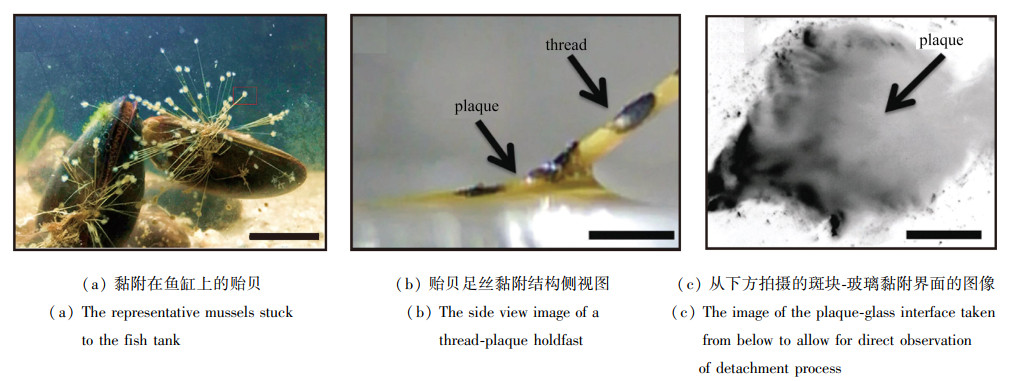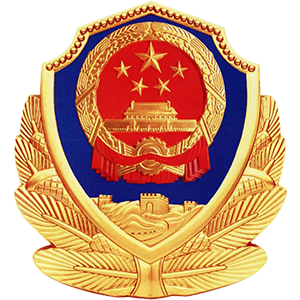| [1] |
COYNE K J, QIN X X, WAITE J H. Extensible collagen in mussel byssus: a natural block copolymer[J]. Science, 1997, 277(5333): 1830-1832. doi: 10.1126/science.277.5333.1830
|
| [2] |
PRIEMEL T, DEGTYAR E, DEAN M N, et al. Rapid self-assembly of complex biomolecular architectures during mussel byssus biofabrication[J]. Nature Communications, 2017, 8(1): 14539. doi: 10.1038/ncomms14539
|
| [3] |
BERTOLDI K, BOYCE M C. Mechanics of the hysteretic large strain behavior of mussel byssus threads[J]. Journal of Materials Science, 2007, 42(21): 8943-8956. doi: 10.1007/s10853-007-1649-z
|
| [4] |
GEORGE M N, CARRINGTON E. Environmental post-processing increases the adhesion strength of mussel byssus adhesive[J]. Biofouling, 2018, 34(4): 388-397. doi: 10.1080/08927014.2018.1453927
|
| [5] |
QIN Z, BUEHLER M J. Impact tolerance in mussel thread networks by heterogeneous material distribution[J]. Nature Communications, 2013, 4(1): 2187. doi: 10.1038/ncomms3187
|
| [6] |
SUHRE M H, GERTZ M, STEEGBORN C, et al. Structural and functional features of a collagen-binding matrix protein from the mussel byssus[J]. Nature Communications, 2014, 5(1): 3392. doi: 10.1038/ncomms4392
|
| [7] |
DESMOND K W, ZACCHIA N A, WAITE J H, et al. Dynamics of mussel plaque detachment[J]. Soft Matter, 2015, 11(34): 6832-6839. doi: 10.1039/C5SM01072A
|
| [8] |
WAITE J H. Mussel adhesion: essential footwork[J]. Journal of Experimental Biology, 2017, 220(4): 517-530. doi: 10.1242/jeb.134056
|
| [9] |
LEE H, DELLATORE S M, MILLER W M, et al. Mussel-inspired surface chemistry for multifunctional coatings[J]. Science, 2007, 318(5849): 426-430. doi: 10.1126/science.1147241
|
| [10] |
AHN B K. Perspectives on mussel-inspired wet adhesion[J]. Journal of the American Chemical Society, 2017, 139(30): 10166-10171. doi: 10.1021/jacs.6b13149
|
| [11] |
PRIEMEL T, PALIA G, FÖRSTE F, et al. Microfluidic-like fabrication of metal ion: cured bioadhesives by mussels[J]. Science, 2021, 374(6564): 206-211. doi: 10.1126/science.abi9702
|
| [12] |
GUO Q, CHEN J, WANG J, et al. Recent progress in synthesis and application of mussel-inspired adhesives[J]. Nanoscale, 2020, 12(3): 1307-1324. doi: 10.1039/C9NR09780E
|
| [13] |
ZHAO Y, WU Y, WANG L, et al. Bio-inspired reversible underwater adhesive[J]. Nature Communications, 2017, 8(1): 1-8. doi: 10.1038/s41467-016-0009-6
|
| [14] |
ARIAS S, AMINI S, KRVGER J M, et al. Implementing Zn2+ ion and pH-value control into artificial mussel glue proteins by abstracting a His-rich domain from preCollagen[J]. Soft Matter, 2021, 17(8): 2028-2033. doi: 10.1039/D0SM02118K
|
| [15] |
KRVGER J M, BOERNER H G. Accessing the next generation of synthetic mussel-glue polymers via mussel-inspired polymerization[J]. Angewandte Chemie International Edition, 2021, 60(12): 6408-6413. doi: 10.1002/anie.202015833
|
| [16] |
ZHANG C, WU B H, ZHOU Y S, et al. Mussel-inspired hydrogels: from design principles to promising applications[J]. Chemical Society Reviews, 2020, 49(11): 3605-3637. doi: 10.1039/C9CS00849G
|
| [17] |
丁洁莹, 薛峰, 苟晓凡. 考虑磁通流动效应的超导薄膜基底结构界面断裂行为研究[J]. 应用数学和力学, 2022, 43(6): 631-638. doi: 10.21656/1000-0887.420353DING Jieying, XUE Feng, GOU Xiaofan. A study on interfacial fracture behaviors of superconducting thin film/substrate structures on taking the account of effects of flux flow[J]. Applied Mathematics and Mechanics, 2022, 43(6): 631-638. (in Chinese) doi: 10.21656/1000-0887.420353
|
| [18] |
QURESHI D A, GOFFREDO S, KIM Y, et al. Why mussel byssal plaques are tiny yet strong in attachment[J]. Matter, 2022, 5(2): 710-724. doi: 10.1016/j.matt.2021.12.001
|
| [19] |
SACHS E M, HAGGERTY J S, CIMA M J, et al. Three-dimensional printing techniques: US patent 5204055[P]. 1993-04-20.
|
| [20] |
GROTH C, KRAVITZ N D, JONES P E, et al. Three-dimensional printing technology[J]. Journal of Clinical Orthodontics, 2014, 48(8): 475-485.
|
| [21] |
ZHANG J, ZHANG X. Simulating low-velocity impact induced delamination in composites by a quasi-static load model with surface-based cohesive contact[J]. Composite Structures, 2015, 125: 51-57. doi: 10.1016/j.compstruct.2015.01.050
|
| [22] |
BELL E C, GOSLINE J M. Mechanical design of mussel byssus: material yield enhances attachment strength[J]. Journal of Experimental Biology, 1996, 199(4): 1005-1017. doi: 10.1242/jeb.199.4.1005
|
| [23] |
BRAZEE S L, CARRINGTON E. Interspecific comparison of the mechanical properties of mussel byssus[J]. The Biological Bulletin, 2006, 211(3): 263-274. doi: 10.2307/4134548
|
| [24] |
GORB S, VARENBERG M, PERESSADKO A, et al. Biomimetic mushroom-shaped fibrillar adhesive microstructure[J]. Journal of The Royal Society Interface, 2007, 4(13): 271-275. doi: 10.1098/rsif.2006.0164
|
| [25] |
SPUSKANYUK A V, MCMEEKING R M, DESHPANDE V S, et al. The effect of shape on the adhesion of fibrillar surfaces[J]. Acta Biomaterialia, 2008, 4(6): 1669-1676. doi: 10.1016/j.actbio.2008.05.026
|
| [26] |
CARBONE G, PIERRO E, GORB S N. Origin of the superior adhesive performance of mushroom-shaped microstructured surfaces[J]. Soft Matter, 2011, 7(12): 5545-5552. doi: 10.1039/c0sm01482f
|
| [27] |
EVANS M A, IAN CAMPBELL R. A comparative evaluation of industrial design models produced using rapid prototyping and workshop-based fabrication techniques[J]. Rapid Prototyping Journal, 2003, 9(5): 344-351. doi: 10.1108/13552540310502248
|
| [28] |
MELCHELS F P, FEIJEN J, GRIJPMA D W. A review on stereolithography and its applications in biomedical engineering[J]. Biomaterials, 2010, 31(24): 6121-6130. doi: 10.1016/j.biomaterials.2010.04.050
|
| [29] |
韩斌慧, 郭紫淇. 冲切模橡胶卸料板设计及其3D打印复膜成型研究[J]. 合成材料老化与应用, 2022, 51(4): 23-25. https://www.cnki.com.cn/Article/CJFDTOTAL-HOCE202204007.htmHAN Binhui, GUO Ziqi. Design of punching die rubber stripper plate and research on 3D printing lamination forming[J]. Synthetic Materials Aging and Application, 2022, 51(4): 23-25. (in Chinese) https://www.cnki.com.cn/Article/CJFDTOTAL-HOCE202204007.htm
|
| [30] |
张超, 刘占芳. 低压对变温环境下高聚物黏结炸药界面损伤的抑制[J]. 应用数学和力学, 2020, 41(10): 1057-1071. doi: 10.21656/1000-0887.410092ZHANG Chao, LIU Zhanfang. Inhibition of low pressure on interfacial damage in polymer bonded explosive under temperature fluctuation[J]. Applied Mathematics and Mechanics, 2020, 41(10): 1057-1071. (in Chinese) doi: 10.21656/1000-0887.410092
|
| [31] |
邓健, 肖鹏程, 王增贤, 等. 基于黏聚区模型的ENF试件层间裂纹扩展分析[J]. 应用数学和力学, 2022, 43(5): 515-523. doi: 10.21656/1000-0887.430082DENG Jian, XIAO Pengcheng, WANG Zengxian, et al. Interlaminar crack propagation analysis of ENF specimens based on the cohesive zone model[J]. Applied Mathematics and Mechanics, 2022, 43(5): 515-523. (in Chinese) doi: 10.21656/1000-0887.430082
|
| [32] |
WAITE J H, ANDERSEN N H, JEWHURST S, et al. Mussel adhesion: finding the tricks worth mimicking[J]. The Journal of Adhesion, 2005, 81(3/4): 297-317.
|





 下载:
下载:










 渝公网安备50010802005915号
渝公网安备50010802005915号